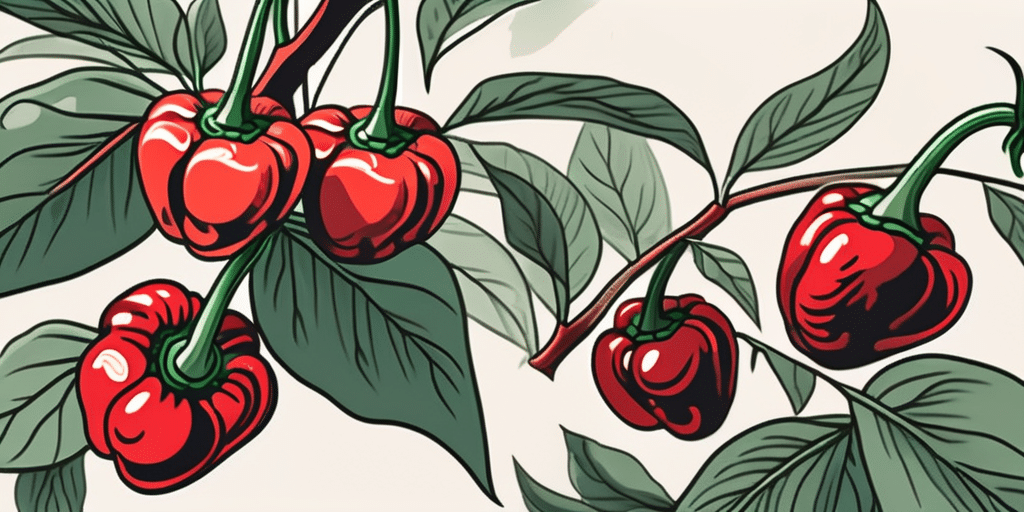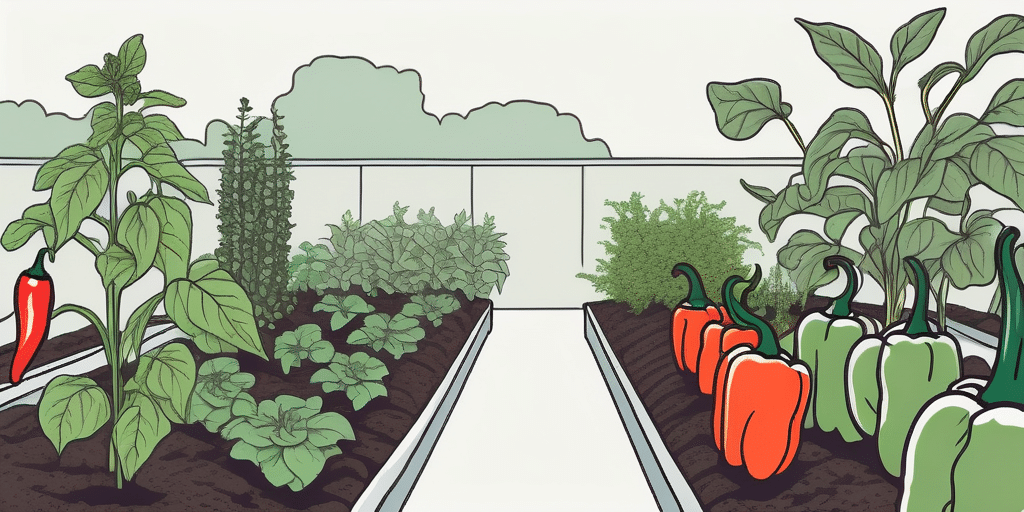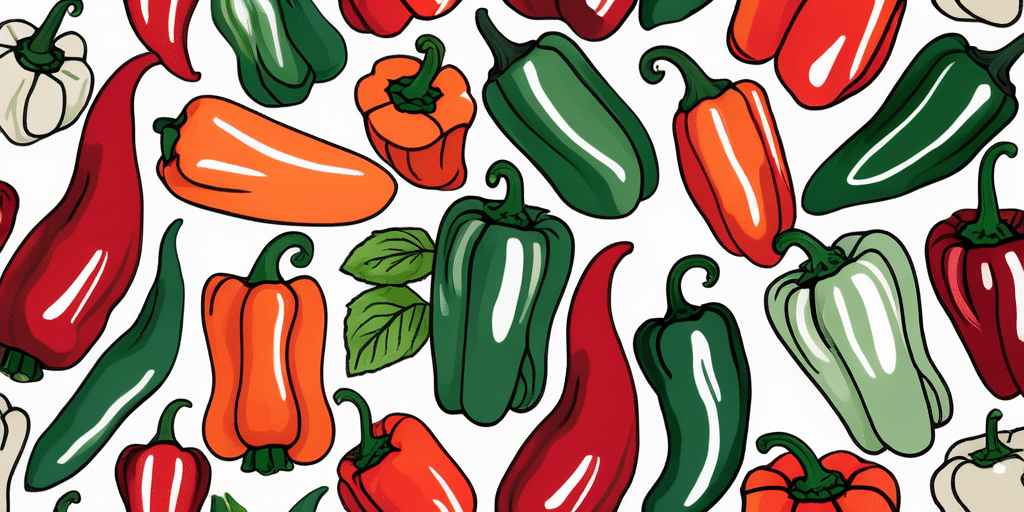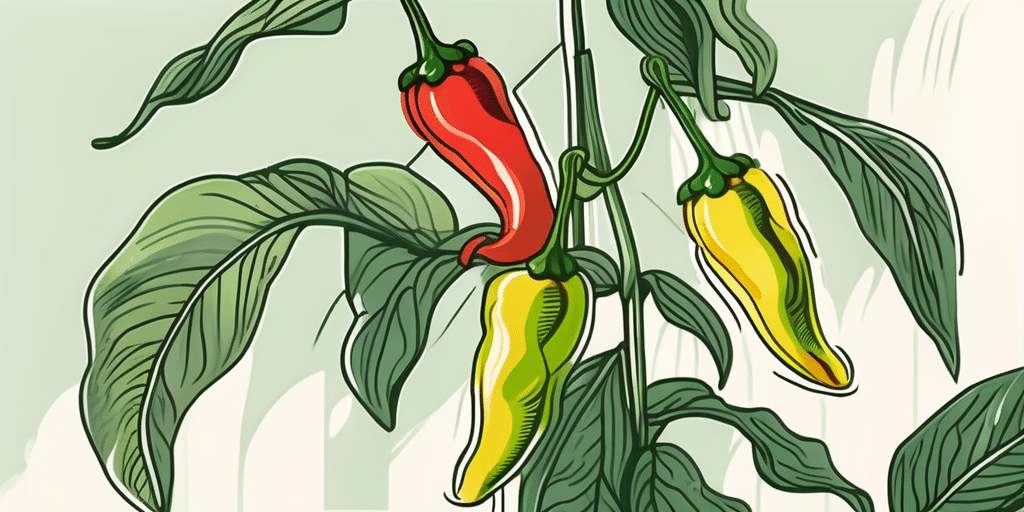Thai Dragon peppers are a popular and fiery variety of chili peppers that can add spice to any dish. If you’re interested in growing these vibrant red peppers in your garden or indoors, this guide will provide you with all the information you need. From starting them from seeds to caring for the plants, harvesting, and even storing the peppers, we’ve got you covered. Let’s dive into the exciting world of Thai Dragon peppers!
When to Start Thai Dragon Peppers
Before you start growing Thai Dragon peppers, it’s essential to know the right time to begin the process. You should start these peppers indoors about 8-10 weeks before the last expected frost in your area. This gives them ample time to establish themselves before being transplanted into the garden.
Thai Dragon peppers, also known as Bird’s Eye chili, are a popular choice for home gardeners due to their fiery heat and vibrant red color. Originating from Thailand, these peppers thrive in warm climates with plenty of sunlight. Starting them indoors allows you to control the growing conditions and ensure a successful harvest.
When starting Thai Dragon peppers from seeds, it’s important to use a well-draining seed starting mix to prevent waterlogged soil, which can lead to root rot. Keep the soil consistently moist but not soggy, and provide bottom heat with a heating mat to encourage germination. Once the seedlings have developed their first set of true leaves, they can be transplanted into individual pots to continue growing until they are ready to be moved outdoors.
How to Grow Thai Dragon Peppers From Seed
Growing Thai Dragon peppers from seed is an enjoyable and rewarding experience. Here’s how you can do it:
- Fill a seed tray or pots with well-draining potting soil.
- Sow the seeds about ¼ inch deep and cover them with a thin layer of soil.
- Water the seeds gently, ensuring that the soil is evenly moist.
- Place the tray or pots in a warm location with indirect sunlight.
- Keep the soil consistently moist but avoid overwatering.
- Within 7-14 days, the seeds will germinate, and you’ll see tiny seedlings sprouting.
Once the seedlings have grown a few sets of leaves, they’re ready to be transplanted.
Expanding on the process, it’s important to note that Thai Dragon peppers thrive in warm climates and require a consistent temperature of around 70-80°F (21-27°C) for optimal growth. If you’re starting your seeds indoors, using a heat mat under the seed tray can help maintain the ideal temperature for germination. Additionally, providing a light source, such as a grow light, can assist in promoting strong and healthy seedling growth.When transplanting the seedlings into larger pots or your garden, make sure to space them about 18-24 inches apart to allow for proper air circulation and room for the plants to mature. Thai Dragon peppers are known for their fiery heat, ranging from 50,000 to 100,000 Scoville Heat Units, so it’s essential to handle them with care, especially when harvesting the mature fruits. As the peppers develop, you can support their growth by fertilizing them with a balanced fertilizer every 2-3 weeks to ensure they receive the necessary nutrients for fruit production.
How and When to Transplant Thai Dragon Peppers
Transplanting Thai Dragon peppers is necessary for them to reach their full potential. These vibrant and fiery peppers are a popular choice for home gardeners looking to add a kick to their culinary creations. Originating from Thailand, these peppers thrive in warm climates and require proper care to flourish.
Follow these steps to ensure a successful transplanting process:
- Choose a sunny spot in your garden with well-draining soil. Thai Dragon peppers love basking in the sun, so select a location that receives at least 6-8 hours of sunlight per day.
- Prepare the soil by loosening it and adding organic matter. Good soil preparation is key to providing the necessary nutrients for the peppers to grow vigorously.
- Dig a hole slightly larger than the root ball of the seedling. This extra space allows the roots to spread out easily and establish themselves in the new environment.
- Gently remove the seedling from the pot, being careful not to damage the roots. Handle the delicate roots with care to prevent shock to the plant.
- Place the seedling in the hole, ensuring that it’s planted at the same depth as it was in the pot. Planting at the correct depth is crucial for the plant’s stability and growth.
- Fill in the hole with soil and gently firm it around the base of the seedling. Ensure there are no air pockets around the roots, as this can lead to drying out and stress for the plant.
- Water the plant thoroughly to help it establish. Proper watering immediately after transplanting helps the roots settle in and reduces transplant shock.
Transplant Thai Dragon peppers outdoors after the danger of frost has passed and the soil has warmed up. These peppers are sensitive to cold temperatures, so it’s essential to wait until all risk of frost has disappeared before moving them outside. Once transplanted, monitor the peppers regularly, providing them with adequate water and nutrients to support their growth and fruit production.
How to Plant Thai Dragon Peppers – Spacing and Patterns
Proper spacing is crucial for optimal growth and productivity of Thai Dragon peppers. Here’s what you need to know:
- Space the plants about 18-24 inches apart.
- Ensure that each plant has enough room to spread out and receive adequate sunlight.
- Consider planting Thai Dragon peppers in rows or clusters.
- Allow a distance of 24-36 inches between rows.
By providing sufficient spacing, you allow air circulation and reduce the risk of diseases.
When selecting a location for planting Thai Dragon peppers, it’s essential to consider the soil quality and drainage. These peppers thrive in well-draining soil with a pH level between 6.0 and 6.5. Adding compost or organic matter to the soil can improve its structure and fertility, providing a healthy foundation for your plants to grow.
In addition to spacing, watering plays a vital role in the successful cultivation of Thai Dragon peppers. These plants require consistent moisture, especially during the flowering and fruiting stages. However, it’s crucial to avoid overwatering, as excessive moisture can lead to root rot and other fungal diseases. Using a soaker hose or drip irrigation system can help deliver water directly to the roots while keeping the foliage dry, reducing the risk of foliar diseases.
How Long to Grow Thai Dragon Peppers
Thai Dragon peppers require patience as they take time to mature. On average, it takes about 80-100 days for these peppers to grow from seed to full maturity. However, remember that growing conditions and varieties can influence the growth timeline.
When growing Thai Dragon peppers, it’s essential to provide them with the right environment to thrive. These peppers prefer warm temperatures between 70-90°F (21-32°C) and plenty of sunlight. They also require well-draining soil to prevent waterlogging, which can stunt their growth.
Additionally, Thai Dragon peppers are known for their spiciness, ranging from 50,000 to 100,000 Scoville Heat Units (SHU). This heat level places them in the upper range of medium-hot peppers, making them a popular choice for adding a fiery kick to dishes.
How to Water Thai Dragon Peppers
Proper watering is essential for the health and productivity of Thai Dragon peppers. Follow these watering tips:
- Water the plants deeply but infrequently.
- Avoid frequent shallow watering, as it can lead to shallow root development.
- Water the plants when the top inch of soil feels dry.
- Avoid wetting the leaves, as it can promote fungal diseases.
- Consider using a drip irrigation system or a soaker hose to provide consistent moisture.
Remember, it’s better to underwater than overwater Thai Dragon peppers.
How to Fertilize Thai Dragon Peppers
Feeding your Thai Dragon peppers with the right nutrients can enhance their growth and productivity. Here’s how to fertilize them:
- Before planting, incorporate well-rotted compost or aged manure into the soil.
- Apply a balanced organic fertilizer when transplanting the seedlings.
- Side dress the plants with compost or a slow-release organic fertilizer halfway through the growing season.
- Avoid over-fertilization, as it can lead to excessive foliage growth and reduced fruit production.
Regularly monitor the plants’ overall health, and adjust the fertilization accordingly.
Sunlight Requirements for Thai Dragon Peppers
Thai Dragon peppers thrive in full sunlight, so be sure to provide them with at least 6-8 hours of direct sunlight per day. They need ample light to produce their signature spicy flavor and vibrant red color.
Soil Requirements for Thai Dragon Peppers
Thai Dragon peppers prefer well-draining soil with a pH level between 6.0 and 7.0. Before planting, conduct a soil test to ensure the soil is within the preferred range. If necessary, amend the soil with organic matter or pH-adjusting amendments to create the ideal conditions.
How to Grow Thai Dragon Peppers Outdoors
Growing Thai Dragon peppers outdoors can be a rewarding experience. Ensure success by following these steps:
- Choose a sunny location in your garden with well-draining soil.
- Prepare the soil by removing any weeds, rocks, or debris.
- Amend the soil with compost or well-rotted manure to improve fertility and drainage.
- Plant the Thai Dragon pepper seedlings following the recommended spacing and planting instructions.
- Water the plants regularly, but avoid overwatering.
- Apply mulch around the plants to conserve moisture and suppress weed growth.
- Monitor the plants for pests and diseases, and take appropriate action if necessary.
With proper care, you’ll soon be enjoying a bountiful harvest of Thai Dragon peppers grown in your garden.
How to Grow Thai Dragon Peppers Indoors
If you have limited space or want to enjoy Thai Dragon peppers all year round, growing them indoors is an excellent option. Here’s how:
- Select a suitable container with drainage holes.
- Fill the container with quality potting soil mixed with organic matter.
- Plant the Thai Dragon pepper seedlings, ensuring they have enough space to grow.
- Place the container in a sunny spot with consistent temperatures between 70-85°F (21-29°C).
- Water the plants regularly, keeping the soil evenly moist but not waterlogged.
- Consider using a fan to simulate airflow and prevent stagnant conditions that can lead to diseases.
- Fertilize the plants according to the guidelines mentioned earlier.
Indoor gardening allows you to enjoy fresh Thai Dragon peppers even during the colder months.
How to Grow Thai Dragon Peppers In Containers and Pots
If space is limited, growing Thai Dragon peppers in containers or pots is a practical solution. Here’s what you need to do:
- Select a container or pot that’s at least 12 inches in diameter and has drainage holes.
- Fill the container with well-draining potting soil mixed with compost.
- Plant one Thai Dragon pepper plant per container.
- Place the containers in a sunny location, preferably near a south-facing window or on a balcony.
- Water the plants regularly, ensuring the soil stays consistently moist but not waterlogged.
- Fertilize the plants every 4-6 weeks using a balanced organic fertilizer.
- Keep an eye out for pests and diseases, especially when growing in containers.
Container gardening offers flexibility and allows you to move the plants as needed.
Thai Dragon Peppers Companion Plants – What to Plant With & Not Plant With Thai Dragon Peppers
Companion planting can benefit Thai Dragon pepper plants, enhancing their growth and deterring pests. Here are some ideal companion plants:
- Basil: The aromatic oils of basil help repel pests while enhancing flavor.
- Marigolds: Marigolds emit a scent that deters harmful insects.
- Nasturtiums: Nasturtium flowers attract aphids away from the pepper plants.
- Oregano: Oregano repels insects and provides flavor when used together in recipes.
On the other hand, there are some plants you should avoid planting near Thai Dragon peppers:
- Fennel: Fennel can inhibit the growth of peppers.
- Kohlrabi: Kohlrabi can compete for nutrients and resources with peppers.
- Potatoes: Planting potatoes near peppers can increase the risk of disease.
- Tomatoes: Tomatoes belong to the same family as peppers and can be susceptible to similar diseases, so it’s usually recommended to avoid planting them in close proximity.
Companion planting is a natural and eco-friendly way to enhance the health of your Thai Dragon pepper plants.
Common Thai Dragon Peppers Pests and Diseases
While Thai Dragon peppers are generally hardy plants, they can still be affected by pests and diseases. Here are a few common ones and how to deal with them:
- Aphids: Rinse off aphids with a strong stream of water or use insecticidal soap.
- Spider Mites: Spray the plants with neem oil or a mixture of water and dish soap.
- Fungal Diseases: Prevent fungal diseases by providing adequate air circulation and avoid overwatering the foliage.
- Blossom End Rot: Maintain consistent moisture levels and provide sufficient calcium to prevent this condition.
If you notice any signs of pests or diseases, take immediate action to prevent them from spreading.
How & When to Harvest Thai Dragon Peppers
Harvesting Thai Dragon peppers at the right time ensures that you enjoy them at their peak flavor and heat level. Here’s what you need to know:
- Wait until the peppers have fully ripened and turned a vibrant red color.
- Use clean garden shears or scissors to cut the peppers from the plant, leaving a short stem attached.
- Harvest the peppers as needed throughout the growing season to encourage continuous fruit production.
Remember to wear gloves while handling Thai Dragon peppers, as the capsaicin can cause skin irritation.
How to Store & Preserve Thai Dragon Peppers
If you have an abundance of Thai Dragon peppers, you can store and preserve them to enjoy later. Here’s how:
- Drying: Hang the peppers in a well-ventilated area until they are thoroughly dried. Once dry, store them in an airtight container.
- Freezing: Wash and dry the peppers, then freeze them whole or chopped in freezer bags or containers.
- Pickling: Preserve the peppers by pickling them in a vinegar-based brine solution. Store the pickled peppers in the refrigerator.
Properly stored Thai Dragon peppers can retain their flavor and heat for several months.
Frequently Asked Questions
Here are some common questions about growing Thai Dragon peppers:
- Are Thai Dragon peppers perennial?
No, Thai Dragon peppers are an annual plant, meaning they complete their life cycle within a year.
- How hot are Thai Dragon peppers?
Thai Dragon peppers are known for their intense heat, ranking around 50,000-100,000 Scoville Heat Units (SHU).
- Can Thai Dragon peppers be used in Thai cuisine?
Absolutely! Thai Dragon peppers are commonly used in Thai cooking to add a spicy kick to dishes.
- Can I save seeds from Thai Dragon peppers?
Yes, you can save seeds from ripe Thai Dragon peppers for future planting.
- How do I prevent cross-pollination with other pepper varieties?
To prevent cross-pollination, it’s important to separate Thai Dragon peppers from other varieties by sufficient distance or physical barriers, such as nets.
With the information provided in this guide, you’re well-equipped to grow your own Thai Dragon peppers. Whether you choose to cultivate them outdoors in your garden or indoors in containers, these fiery peppers will bring an exciting touch to your culinary adventures. Get ready to spice up your meals with the fantastic flavors of Thai Dragon peppers!
Join Our Growing Community
Ready to turn up the heat in your garden with Thai Dragon peppers and more? Subscribe for free to How to Grow Everything and learn how to build the garden of your dreams! Receive personalized gardening advice tailored to your location, grow zone, and experience level. Enjoy the best gardening tips, special offers, and deals delivered straight to your inbox—100% free, from our family to yours. No spam, just the support you need to grow everything you can imagine. Let’s get planting!





